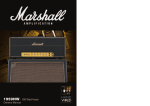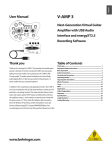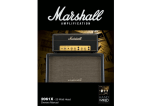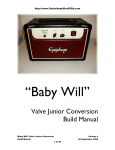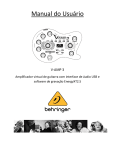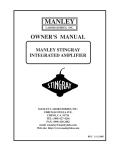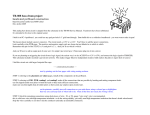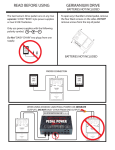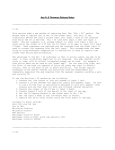Download the 2245THW™ Handbook
Transcript
Congratulations on your purchase of this all-valve, hand-wired amplifier – part of Marshall’s revered Handwired Series. Every head and combo in this expertly-crafted range has been designed, engineered and constructed to the highest possible standards at the Marshall factory in the heart of England. Based on original vintage Marshall amps produced in the ‘60s and early ‘70s, the Handwired Series has been created to be both sonically and visually as authentic as possible. But why did Marshall founder, the late, great Jim Marshall OBE, want to produce such a range? The reason Jim decided to create the Handwired Series was simple – public demand. One of the things Jim loved was meeting with and talking to guitarists at the many trade shows, music fairs and shop appearances he attended all over the world. A subject that almost always seemed to come up in conversation at such events was hand-wiring. Jim realised that, even in this mass-produced digital age, there was still a demand for authentically hand-crafted guitar amplifiers. The continuing success of the Marshall Handwired Series is testament to Jim’s thinking. In order to recreate the look, feel and tone of those much sought-after originals, the Marshall team of designers have gone to enormous lengths to seek out and/ or reproduce all of the original components and materials, whilst also revisiting the original methods of construction. From the hand-wired tag-board circuit to the custom-manufactured Dagnall output and mains transformers, we are extremely proud of the incredible accuracy and authenticity of these re-issued amplifiers. We sincerely hope that this hand-wired piece of Marshall history will provide you with countless hours of playing pleasure. Yours Sincerely, The Marshall Team Follow all instructions and heed all warnings KEEP THESE INSTRUCTIONS ! EUROPE ONLY - Note: This equipment has been tested and found to comply with the requirements of the EMC Directive (Environments E1, E2 and E3 EN 55103-1/2) and the Low Voltage Directive in the E.U. EUROPE ONLY - Note: The Peak Inrush current for the 1974X is 10 amps. The Peak Inrush current for the 1958X is XX amps. The Peak Inrush current for the 1973X is XX amps. The Peak Inrush current for the 1962HW is 26 amps. The Peak Inrush current for the 2061X is 11 amps. The Peak Inrush current for the 2245THW is XX amps. The Peak Inrush current for the 1959HW is 76 amps. 1 Handwired Series Overview Our goal when designing the UK made Handwired Series was both obvious and simple: to make all the models in the range as close to the originals as possible in terms of components, circuitry, constructional methods, materials, specifications, aesthetics, signal path, performance, tonal characteristics and feel. We’ve gone to incredible lengths to achieve maximum authenticity and are delighted to report that our suppliers were equally as exacting in their tasks. Every model in the Handwired range possesses it’s own unique tonal identity and yet they all share a common sonic ‘DNA’. Namely those aggressive yet sweetly distorted, harmonically rich, musical tones resulting from perfectly crafted circuitry and overdriven power valves. When ‘cranked’ the amps and combos deliver pure vintage crunch and become incredibly touch-sensitive, cleaning up or, if desired, sitting right on the edge of distortion when the guitar’s volume is turned down. Not surprisingly, all the Handwired models respond extremely well to picking dynamics, indefatigably ‘in-your-face’ when you play like you really mean it and cleaning up as you pull back on your picking attack. The 1959HW is a Class-A/B, all-valve, 100 Watt, twochannel head. The circuit we have revisited for the 1959HW boasts several ‘tonally significant’ variants when compared to the slightly later circuit we use for our critically acclaimed, standard-production Plexi re-issue - the 1959SLP. The most sonically relevant technical departures in question lie in the negative feedback circuit. painstakingly revisited by our friends at Celestion – right the way down to recreating the original “Amplification by Marshall” gold label and also painting the back of the magnet silver. The speakers obviously play a vital sonic role as well as a cosmetic one so Celestion’s meticulous nature is greatly appreciated. As you can see from its front panel layout, the 1959HW is an extremely straightforward amplifier. Its two channels - Channel I and Channel II - each have two inputs (High and Low sensitivity) and separate Volume controls, while sharing the amplifier’s four tone controls: Presence, Bass, Middle and Treble. Like all Marshall, all-valve amplifiers, the 1959 sounds at its very best when turned up full and because of its conservative power rating and astonishing projection, is a formidable live amplifier in even the largest of venues. 2245THW The 2245THW can be thought of as either the original 2245 with added tremolo (hence the ‘T’ in the model name), or as a head version of the 1962HW. Either way, all the features and components (minus the speakers of course) are identical to the 1962HW. 1962HW The 1962HW is an all-valve, 30 Watt, two channel, 2x12” combo and is a faithful recreation of the legendary ‘Bluesbreaker’, harkening back to the original format and circuit topology of the first production run back in 1965. Both channels feature high and low sensitivity inputs with separate Volume controls and a shared an EQ section containing Presence, Bass, Middle and Treble. The 1962HW’s Tremolo circuit is governed by Speed and Intensity controls. 1959HW As is now rock folklore, the 1959 came to be when The Who’s guitarist, Pete Townshend, approached Marshall in the mid ’60s and asked Jim to build him a ‘weapon’ that would allow him to play so loud that he wouldn’t be able to hear what the members of the audience were saying, should they have the sheer audacity to talk whilst he was performing! Jim and his team obliged and within weeks of Pete’s request one of rock’s most instantly recognisable icons was born - the 100 Watt Marshall stack. Over the years the Tremolo circuit has been the main target for many design improvements. However, despite the Tremolo being reconfigured to give an undoubtedly superior effect, its connection to the signal path was also changed which, in turn, had a sonic influence. For this tonal reason, we’ve reverted back to the original valve Tremolo circuit as it’s undeniably part of the 1962’s “mojo”. The transformers are supplied by our long-time partners at Drake who manufactured the originals all those years ago. To add to the authenticity of these all important components, the Drake engineers used the original designs and worked meticulously to duplicate the originals. Needless to say, with the exception of a few necessary adjustments to satisfy strict modern safety standards, the resulting transformers are as close as humanly possible to the originals. The 1959 head first saw the light of day in late 1965 and was affectionately dubbed the Plexi because of the material used for its front panel. Although we continued to build 1959s, the now legendary Plexiera came to an end in July 1969 when we started using gold anodised aluminium panels instead of Plexiglas. While all original Plexi 1959s are held in the highest esteem, several subtly different but tonally significant circuit variations existed - the most celebrated and revered versions being those made between 1967 and 1969. A definite contributing factor in the sound of the vintage 1974 amplifiers is the way the Celestion Greenback loudspeaker sound softens with age. Celestion revisited the 1967 recipe for the original 20 Watt, ceramic magnet, 15 Ohm, Greenback T1221 speaker used in the 1974 and supply it to us exclusively. They meticulously duplicated every critical vintage parameter from winding lengths, coil former dimensions and edge treatment to using the original dustcap material and adhesive. In sound tests these speakers were close, but still lacked something of the sonic signature of the originals. 1958X and 1973X Both of these combos are variants of the 1974X; the 1958X features 2 x 10” Celestion aged Greenbacks while the 1973X house the same quantity of 12” Celestion ‘Greenbacks’. All other features, components and construction are identical to the 1974X. 2061X The 2061X is an all-valve, 20 Watt, two-channel head with no negative feedback in its cathode-biased output stage. As you can see from its front panel layout, the 2061X is an extremely straightforward amplifier with both of its channels only boasting a Volume and Tone control each. Unlike its 18 Watt predecessors which boasted an EZ81 rectifier, the 2061X features a solid-state, silicon diode rectifying device, and is a much more aggressive and surprisingly modern sounding amplifier, while still possessing that unmistakable and highly desirable, vintage all-valve tone. 1974X The 1974X is an all-valve, 18 Watt, two-channel, 1x12” combo with valve driven tremolo and, just like the 2061X, no negative feedback in its cathodebiased output stage. Channel 1 (the non-tremolo channel) only boasts two, self-explanatory controls: Volume and Tone; while Channel 2, the Tremolo Channel, boasts four – namely Volume and Tone, plus Speed and Intensity for the valve driven tremolo circuit. The 15 Ohm, G12 T652 Alnico magnet speakers used in the original Series II model 1962 have been 2 3 1974X Front Panel 1 2 3 1974X Rear Panel 4 5 6 7 8 9 10 11 1. INDICATOR This filament bulb indicator will light up when your amplifier is switched on. It will not be lit when the amplifier is switched off and/or is not receiving mains power. 5. TREMOLO INTENSITY CONTROL This controls the intensity or depth of the tremolo oscillation when the effect is being used. The effect depth increases when the Intensity control is turned clockwise and decreases when it is turned 2. STANDBY SWITCH The Standby Switch is used in conjunction with the Power Switch (item 3) to ‘warm up’ the amplifier before use and to prolong the life of the output valves. When powering up the amplifier always engage the Power Switch first, leaving the Standby switch on ‘Standby’. This allows the application of the voltage required to heat the valves to their correct operating temperature – hence the switch’s name. After approximately two minutes the valves will have reached the correct operating temperature and the Standby Switch can be engaged. Upon doing this the H.T. (High Tension) voltage required by the two EL84 output valves to pass signal (and hence produce sound) is applied. In order to prolong valve life, the Standby Switch alone should also be used to turn the amplifier ‘on’ and ‘off’ during breaks in a performance. Also, upon full power down, always disengage the Standby Switch prior to the main Power Switch. 6. TONE CONTROL This adjusts the tonal character of the Tremolo Channel. Turning this control clockwise increases the amount of high frequencies (treble) present in the sound. 7. VOLUME CONTROL This controls the volume of the Tremolo Channel. Turning it clockwise increases the volume level of the channel. 8. CHANNEL 2 INPUTS These are the guitar inputs for the Tremolo Channel. The top one is the ‘high sensitivity’ input for this channel, the bottom one is the ‘low sensitivity’ input which is 6dB lower (i.e. half) than the ‘high sensitivity’ input and has a darker sound. Always use a high quality screened guitar lead. CHANNEL 1 - THE NON-TREMOLO CHANNEL 9. TONE CONTROL This controls the tonal character of Channel 1. Turning the tone control clockwise increases the amount of high frequencies (treble) present in the sound. 3. POWER SWITCH This is the On/Off switch for mains power to the amplifier. Note: Please ensure the amplifier is switched off and unplugged from the mains electricity supply whenever it is moved. 1 2 1. TREMOLO FOOTSWITCH JACK This is where the supplied Tremolo on/off footswitch is plugged in. 2. LOUDSPEAKER OUTPUTS There are two parallel loudspeaker output jacks provided for connection to the internal speaker and/ or an external load, i.e. speaker extension cabinet(s). When connecting speaker(s) please always ensure that the amplifier’s output impedance is set correctly (item 3). WARNING! Never use the combo without a load attached! Always use a non-screened Marshall approved speaker lead when connecting an extension cabinet to these units. 5 6 4. MAINS FUSE The correct value of mains fuse is specified on the rear panel of the amplifier. NEVER attempt to bypass the fuse or fit one of the incorrect value. 5. H.T. FUSE The correct value of H.T. fuse is specified on the rear panel of the amplifier. NEVER attempt to bypass the fuse or fit one of the incorrect value. 3. OUTPUT IMPEDANCE SELECTOR Matches the amplifier’s output to the load (speaker) impedance. As is the case with any Marshall all-valve amplifier it is imperative that: a) the amplifier is connected to a load whilst in operation and b) the impedance selected on the amplifier matches the total impedance of the internal speaker and/or extension speaker cabinets. The combo’s internal speaker is 15 Ohms so when it is being used by itself the Impedance Selector must be set to 16 Ohms. If an additional 16 Ohm extension speaker cabinet is used in conjunction with the internal speaker the Impedance Selector should be set to 8 Ohms. 6. MAINS INPUT Your amp is provided with a detachable mains (power) lead, which is connected here. The specific mains input voltage rating that your amplifier has been built for is shown on the back panel. Before connecting for the first time, please ensure that your amplifier is compatible with your electricity supply. If you have any doubt, please get advice from a qualified technician. Your Marshall dealer will help you in this respect. 11. CHANNEL 1 INPUTS These are the guitar inputs for this Channel and both are identical. 4 4 WARNING! An extension speaker cabinet with an impedance of less than 16 Ohms should NOT be used in conjunction with the internal speaker. The amp should be completely powered down before the Output Impedance Selector is turned. Failure to comply with any of the points raised in this section will result in damage to the amplifier. 10. VOLUME CONTROL This controls the volume of Channel 1. Turning it clockwise increases the volume level of the channel. CHANNEL 2 - THE TREMOLO CHANNEL 4. TREMOLO SPEED CONTROL This controls the speed of tremolo oscillation when this effect (which can be switched on/off via the supplied footswitch) is being used. Oscillation speed increases when the Speed control is turned clockwise and decreases when it is turned anticlockwise. 3 5 1958X Front Panel 1 2 3 1958X Rear Panel 4 5 6 7 8 9 10 11 1. INDICATOR This filament bulb indicator will light up when your amplifier is switched on. It will not be lit when the amplifier is switched off and/or is not receiving mains power. 5. TREMOLO INTENSITY CONTROL This controls the intensity or depth of the tremolo oscillation when the effect is being used. The effect depth increases when the Intensity control is turned clockwise and decreases when it is turned 2. STANDBY SWITCH The Standby Switch is used in conjunction with the Power Switch (item 3) to ‘warm up’ the amplifier before use and to prolong the life of the output valves. When powering up the amplifier always engage the Power Switch first, leaving the Standby switch on ‘Standby’. This allows the application of the voltage required to heat the valves to their correct operating temperature – hence the switch’s name. After approximately two minutes the valves will have reached the correct operating temperature and the Standby Switch can be engaged. Upon doing this the H.T. (High Tension) voltage required by the two EL84 output valves to pass signal (and hence produce sound) is applied. In order to prolong valve life, the Standby Switch alone should also be used to turn the amplifier ‘on’ and ‘off’ during breaks in a performance. Also, upon full power down, always disengage the Standby Switch prior to the main Power Switch. 6. TONE CONTROL This adjusts the tonal character of the Tremolo Channel. Turning this control clockwise increases the amount of high frequencies (treble) present in the sound. 7. VOLUME CONTROL This controls the volume of the Tremolo Channel. Turning it clockwise increases the volume level of the channel. 8. CHANNEL 2 INPUTS These are the guitar inputs for the Tremolo Channel. The top one is the ‘high sensitivity’ input for this channel, the bottom one is the ‘low sensitivity’ input which is 6dB lower (i.e. half) than the ‘high sensitivity’ input and has a darker sound. Always use a high quality screened guitar lead. CHANNEL 1 - THE NON-TREMOLO CHANNEL 9. TONE CONTROL This controls the tonal character of Channel 1. Turning the tone control clockwise increases the amount of high frequencies (treble) present in the sound. 3. POWER SWITCH This is the On/Off switch for mains power to the amplifier. Note: Please ensure the amplifier is switched off and unplugged from the mains electricity supply whenever it is moved. 1 2 1. TREMOLO FOOTSWITCH JACK This is where the supplied Tremolo on/off footswitch is plugged in. 2. LOUDSPEAKER OUTPUTS There are two parallel loudspeaker output jacks provided for connection to the internal speaker and/ or an external load, i.e. speaker extension cabinet(s). When connecting speaker(s) please always ensure that the amplifier’s output impedance is set correctly (item 3). WARNING! Never use the combo without a load attached! Always use a non-screened Marshall approved speaker lead when connecting an extension cabinet to these units. 5 6 4. MAINS FUSE The correct value of mains fuse is specified on the rear panel of the amplifier. NEVER attempt to bypass the fuse or fit one of the incorrect value. 5. H.T. FUSE The correct value of H.T. fuse is specified on the rear panel of the amplifier. NEVER attempt to bypass the fuse or fit one of the incorrect value. 3. Output Selector Matches the amplifier’s output to the load impedance. With all-valve amplifiers it is imperative that the amplifier is connected to a load whilst in operation and that the impedance selected on the amplifier matches the total impedance of the internal speakers and/or extension speaker cabinets. Important Note: Failure to do so will result in damge to the amplifier. The two internal speakers are 16 Ohms each. These are wired in parallel giving an overall impedance of 8 Ohms, therefore the output selector should be set to 8 Ohms. If a 16 Ohm extension speaker cabinet is used instead of the internal speakers the output selector should be set to 16 Ohms. 6. MAINS INPUT Your amp is provided with a detachable mains (power) lead, which is connected here. The specific mains input voltage rating that your amplifier has been built for is shown on the back panel. Before connecting for the first time, please ensure that your amplifier is compatible with your electricity supply. If you have any doubt, please get advice from a qualified technician. Your Marshall dealer will help you in this respect. 11. CHANNEL 1 INPUTS These are the guitar inputs for this Channel and both are identical. 6 4 Note: No additional extension speaker cabinet with an impedance lower than 8 Ohms should be used. Failure to comply with these points will result in damage to the amplifier. Your amp should be completely powered down before the selector is turned. 10. VOLUME CONTROL This controls the volume of Channel 1. Turning it clockwise increases the volume level of the channel. CHANNEL 2 - THE TREMOLO CHANNEL 4. TREMOLO SPEED CONTROL This controls the speed of tremolo oscillation when this effect (which can be switched on/off via the supplied footswitch) is being used. Oscillation speed increases when the Speed control is turned clockwise and decreases when it is turned anticlockwise. 3 7 1973X Front Panel 1 2 3 1973X Rear Panel 4 5 6 7 8 9 10 11 1. INDICATOR This filament bulb indicator will light up when your amplifier is switched on. It will not be lit when the amplifier is switched off and/or is not receiving mains power. 5. TREMOLO INTENSITY CONTROL This controls the intensity or depth of the tremolo oscillation when the effect is being used. The effect depth increases when the Intensity control is turned clockwise and decreases when it is turned 2. STANDBY SWITCH The Standby Switch is used in conjunction with the Power Switch (item 3) to ‘warm up’ the amplifier before use and to prolong the life of the output valves. When powering up the amplifier always engage the Power Switch first, leaving the Standby switch on ‘Standby’. This allows the application of the voltage required to heat the valves to their correct operating temperature – hence the switch’s name. After approximately two minutes the valves will have reached the correct operating temperature and the Standby Switch can be engaged. Upon doing this the H.T. (High Tension) voltage required by the two EL84 output valves to pass signal (and hence produce sound) is applied. In order to prolong valve life, the Standby Switch alone should also be used to turn the amplifier ‘on’ and ‘off’ during breaks in a performance. Also, upon full power down, always disengage the Standby Switch prior to the main Power Switch. 6. TONE CONTROL This adjusts the tonal character of the Tremolo Channel. Turning this control clockwise increases the amount of high frequencies (treble) present in the sound. 7. VOLUME CONTROL This controls the volume of the Tremolo Channel. Turning it clockwise increases the volume level of the channel. 8. CHANNEL 2 INPUTS These are the guitar inputs for the Tremolo Channel. The top one is the ‘high sensitivity’ input for this channel, the bottom one is the ‘low sensitivity’ input which is 6dB lower (i.e. half) than the ‘high sensitivity’ input and has a darker sound. Always use a high quality screened guitar lead. CHANNEL 1 - THE NON-TREMOLO CHANNEL 9. TONE CONTROL This controls the tonal character of Channel 1. Turning the tone control clockwise increases the amount of high frequencies (treble) present in the sound. 3. POWER SWITCH This is the On/Off switch for mains power to the amplifier. Note: Please ensure the amplifier is switched off and unplugged from the mains electricity supply whenever it is moved. 1 2 1. TREMOLO FOOTSWITCH JACK This is where the supplied Tremolo on/off footswitch is plugged in. 2. LOUDSPEAKER OUTPUTS There are two parallel loudspeaker output jacks provided for connection to the internal speaker and/ or an external load, i.e. speaker extension cabinet(s). When connecting speaker(s) please always ensure that the amplifier’s output impedance is set correctly (item 3). WARNING! Never use the combo without a load attached! Always use a non-screened Marshall approved speaker lead when connecting an extension cabinet to these units. 5 6 4. MAINS FUSE The correct value of mains fuse is specified on the rear panel of the amplifier. NEVER attempt to bypass the fuse or fit one of the incorrect value. 5. H.T. FUSE The correct value of H.T. fuse is specified on the rear panel of the amplifier. NEVER attempt to bypass the fuse or fit one of the incorrect value. 3. Output Selector Matches the amplifier’s output to the load impedance. With all-valve amplifiers it is imperative that the amplifier is connected to a load whilst in operation and that the impedance selected on the amplifier matches the total impedance of the internal speakers and/or extension speaker cabinets. Important Note: Failure to do so will result in damge to the amplifier. The two internal speakers are 16 Ohms each. These are wired in parallel giving an overall impedance of 8 Ohms, therefore the output selector should be set to 8 Ohms. If a 16 Ohm extension speaker cabinet is used instead of the internal speakers the output selector should be set to 16 Ohms. 6. MAINS INPUT Your amp is provided with a detachable mains (power) lead, which is connected here. The specific mains input voltage rating that your amplifier has been built for is shown on the back panel. Before connecting for the first time, please ensure that your amplifier is compatible with your electricity supply. If you have any doubt, please get advice from a qualified technician. Your Marshall dealer will help you in this respect. 11. CHANNEL 1 INPUTS These are the guitar inputs for this Channel and both are identical. 8 4 Note: No additional extension speaker cabinet with an impedance lower than 8 Ohms should be used. Failure to comply with these points will result in damage to the amplifier. Your amp should be completely powered down before the selector is turned. 10. VOLUME CONTROL This controls the volume of Channel 1. Turning it clockwise increases the volume level of the channel. CHANNEL 2 - THE TREMOLO CHANNEL 4. TREMOLO SPEED CONTROL This controls the speed of tremolo oscillation when this effect (which can be switched on/off via the supplied footswitch) is being used. Oscillation speed increases when the Speed control is turned clockwise and decreases when it is turned anticlockwise. 3 9 1962HW Front Panel MAINS STANDBY 1962HW Rear Panel SPEED JTM INTENSITY 4 6 0 10 2 ON 1 8 4 6 0 10 2 PRESENCE 8 4 6 0 10 2 BASS 8 MIDDLE 4 6 0 10 2 8 4 6 0 10 2 8 TREBLE VOLUME I VOLUME II 4 6 4 6 4 6 0 10 0 10 0 10 2 8 2 8 2 1 8 1 ON 2 2 INPUTS FOOT PEDAL 2 Bar Code PANL-00303 v1 1962HW 230V 3 4 5 6 7 1. Power Switch On/Off Switch for mains power to the amplifier. Please ensure the amplifier is switched off and unplugged from the mains electricity supply before being moved. 2. Standby Switch The Standby Switch is used in conjunction with the Power Switch to ‘warm up’ the amplifier before use and to prolong the life of the output valves. When powering up the amplifier always engage the Power Switch first. This allows the application of the voltage required to heat the valves to their correct operating temperature. After about 2 minutes, when the valves are up to the correct temperature, the Standby Switch can be engaged. Upon doing this the H.T. (High Tension) which is the high voltage required by the output valves to pass signal (and hence produce sound) is applied. To prolong valve life, the Standby Switch alone should be used to turn the amplifier on and off during breaks in a performance. Also, upon full power down, always disengage the Standby Switch prior to the main Power Switch. 8 9 10 11 12 13 14 15 4 230V - T500mAE250V 100V/120V - T500mAE250V 230V ~ 50Hz 175 Watts 230V - T1AE250V 100V/120V - T2AE250V 5 6 7 4. Mains Selector Matches the amplifier mains transformer voltage to the incoming mains voltage. Ensure that the rotary Mains Selector is set to the correct mains voltage applicable to the country where used. If you do not know the mains input voltage contact your authorised Marshall dealer. Your amp should be completely powered down before the selector is turned. Adjustment from 230v to 120v to 100v or vice versa will require the mains fuse to be changed to the corresponding value as detailed on the rear panel. 3. Output Selector Matches the amplifier’s output to the load impedance. With all-valve amplifiers it is imperative that the amplifier is connected to a load whilst in operation and that the impedance selected on the amplifier matches the total impedance of the internal speakers and/or extension speaker cabinets. Important Note: Failure to do so will result in damge to the amplifier. The two internal speakers are 16 Ohms each. These are wired in parallel giving an overall impedance of 8 Ohms, therefore the output selector should be set to 8 Ohms. If a 16 Ohm extension speaker cabinet is used instead of the internal speakers the output selector should be set to 16 Ohms. Note: No additional extension speaker cabinet with an impedance lower than 8 Ohms should be used. Failure to comply with these points will result in damage to the amplifier. Your amp should be completely powered down before the selector is turned. Note: The electrical characteristics of the 1962HW’s transformers are identical in every single aspect to the original ones used back in 1965. The inclusion of the 100V Line tap, while being historically correct, is of little or no use on this particular model, if truth be told. The reason it was present in the 60s was because certain amps were able to drive multiple remote 100V line speakers in various locations 5. H.T. Fuse The correct value of H.T. fuse is specified on the rear panel of the amplifier. 6. Mains Input Your amp is provided with a detachable mains (power) lead which is connected here. The specific mains input voltage rating that your amplifier has been built for is shown on the back panel. Before connecting for the first time, please ensure that your amplifier is compatible with your electricity supply. If you have any doubt, please get advice from a qualified person. Your Marshall dealer will help in this respect. 7. Mains Fuse The correct value of mains fuse is specified on the rear panel of the amplifier. 15. Input Jack Connects the guitar to the lower sensitivity input on Channel 2. 8. Middle Control Dictates the middle register of the amplifier. Turning this up will make your guitar sound fatter. Conversely 10 3 MAINS FUSE 2. Loudspeaker Output This is for connection to either the internal speakers and/or an external load, i.e. speaker extension cabinet. 14. Input Jack Connects the guitar to Channel 2. 7. Bass Control Controls the amount of low frequencies or bottom end in your tone. MAINS MAINS INPUT 9. Treble Control Controls the high frequencies of the guitar tone, making your guitar sound brighter when increased. Note: The tone network is highly interactive and altering one control can change the shape of the sound in relation to the other tone controls. Experimentation is the best way to achieve your desired sounds. 13. Input Jack Connects the guitar to the lower sensitivity input on Channel 1. 6. Presence Control Adds higher frequencies to the guitar tone, creating crispness and bite. Turning this up will make the sound more cutting and ‘present’. OUTPUT H.T FUSE within a particular venue. This option is effectively the 1962HW’s appendix – an anatomically correct but vestigial feature! 12. Input Jack Connects the guitar to Channel 1. Note: Though the first input of the first channel is the input that most guitarists use, don’t be afraid to experiment. Some guitar players prefer to mix the two channels together by connecting a short, screened patch lead between the second input of Channel 1 and the first input of Channel 2. If you then plug your guitar into the 2 first input of Channel 1 (item 12), 1 you can mix the different tonal INPUTS characters of each channel for 1 2 greater flexibility. 5. Intensity Control Controls the intensity of oscillation (i.e. the effect depth) when using the Tremolo effect. Note: The tremolo effect will only work when playing through Channel 2 of the 1962 combo. 2 SELECTOR 1. Footpedal Jack For connection of the supplied footswitch to allow Tremolo to be switched on and off. 11. Volume II Controls the overall output level of Channel 2. Note: Channel 2 is voiced for normal response. 4. Speed Control Controls the speed of oscillation when using the Tremolo effect. CONNECT SPEAKERS BEFORE USE OUTPUT: 30 WATTS RMS SELECTOR reducing the amount of middle in your tone will result in a sharper and thinner guitar sound for a more ‘scooped’ tone. 10. Volume I Controls the overall output level of Channel 1. Note: This channel is voiced for a higher treble response than Channel 2. 3. Indicator The Indicator will be lit when your amplifier is on and will not be lit when the amplifier is switched off. 1 SPEAKER 11 2061X Front Panel 1 2061X Rear Panel 2 3 4 5 6 7 8 1. POWER SWITCH This is the On/Off switch for mains power to the amplifier. Note: Please ensure the amplifier is switched off and unplugged from the mains electricity supply whenever it is moved. 8. BASS CHANNEL INPUTS These are the guitar inputs for the Bass Channel. The top input is ‘high sensitivity’ and the bottom input is ‘low sensitivity’, the latter being 6dB lower in volume than the former with a darker sound. Always use a high-quality, screened guitar cable. 2. INDICATOR This 6.3 Volt incandescent filament indicator will light up when your amplifier is switched on. It will not be lit when the amplifier is switched off and/or is not receiving mains power. PERFORMANCE NOTE Bridging or ‘jumping’ the two channels Because both Channels of the 2061X have the same number of gain stages (one) and are therefore in phase with each other, it is possible to bridge them together (a.k.a. ‘slaving’, ‘jumping’, ‘linking’ or even ‘daisy-chaining’) and use them both at the same time, enabling you to expand upon the amps tonal possibilities by mixing the Lead and Bass channels together. The most common way of doing this is to plug your guitar into the top (high sensitivity) input of one of the two channels and then run a short ‘jumper’ guitar cable (i.e. a screened cable) from that channel’s bottom (low sensitivity) input to one of the other channel’s two inputs. It is also possible to plug your guitar into the bottom (low sensitivity) input of one of the two channels and then run the ‘jumper’ cable from its top (high sensitivity) input to one of the other channel’s two inputs. This less-common approach can also yield some interesting tonal variations. LEAD CHANNEL 3. TONE CONTROL This adjusts the tonal character of the Lead Channel. Turning this control clockwise increases the amount of high frequencies (treble) in the sound. 4. VOLUME CONTROL This controls the volume of the Lead Channel. Turning it clockwise increases the volume level of the channel. 5. LEAD CHANNEL INPUTS These are the guitar inputs for the Lead Channel. The top input is ‘high sensitivity’ and the bottom input is ‘low sensitivity’, the latter being 6dB lower in volume than the former with a darker sound. Always use a high-quality, screened guitar lead. BASS CHANNEL 6. TONE CONTROL This adjusts the tonal character of the Bass Channel. Turning this control clockwise increases the amount of high frequencies (treble) in the sound. 1 2 1. LOUDSPEAKER OUTPUTS There are two parallel loudspeaker output jacks provided for connection to speaker extension cabinet(s). Please always ensure that the amplifier’s output impedance is set correctly . WARNING! Never use the head without a load attached! Always use a non-screened Marshall approved speaker lead when connecting an extension cabinet to these units. 12 4 5 with your electricity supply. If you have any doubt, please get advice from a qualified technician. Your Marshall dealer will help you in this respect. 5. MAINS FUSE The correct value of mains fuse is specified on the rear panel of the amplifier. NEVER attempt to bypass the fuse or fit one of the incorrect value. 2. OUTPUT IMPEDANCE SELECTOR Matches the amplifier’s output to the load (speaker) impedance. As is the case with any Marshall all-valve amplifier it is imperative that: a) the amplifier is connected to a load whilst in operation and b) the impedance selected on the amplifier matches the total impedance of the extension speaker cabinets being used. WARNING! An extension speaker cabinet with an impedance of less than 4 Ohms, or two extension cabinets of 4 Ohms or less should NOT be used with this head. The amp should be completely powered down before the Output Impedance Selector is turned. Failure to comply with any of the points raised in this section will result in damage to the amplifier. 3. H.T. FUSE The correct value of H.T. fuse is specified on the rear panel of the amplifier. NEVER attempt to bypass the fuse or fit one of the incorrect value. 4. MAINS INPUT Your amp is provided with a detachable mains (power) lead, which is connected here. The specific mains input voltage rating of your amplifier is shown on the back panel. Before connecting for the first time, please ensure that your amplifier is compatible 7. VOLUME CONTROL This controls the volume of the Bass Channel. Turning it clockwise increases the volume level of the channel. 3 13 2245THW Front Panel MAINS STANDBY SPEED JTM INTENSITY 4 6 0 10 2 ON 1 2245THW Rear Panel 8 4 6 0 10 2 PRESENCE 8 4 6 0 10 2 BASS 8 MIDDLE 4 6 0 10 2 8 4 6 0 10 2 8 TREBLE VOLUME I VOLUME II 4 6 4 6 4 6 0 10 0 10 0 10 2 8 2 8 2 1 8 1 ON 2 2 INPUTS FOOT PEDAL 2 Bar Code PANL-00303 v1 2245THW 230V 3 4 5 6 7 1. Power Switch On/Off Switch for mains power to the amplifier. Please ensure the amplifier is switched off and unplugged from the mains electricity supply before being moved. 2. Standby Switch The Standby Switch is used in conjunction with the Power Switch to ‘warm up’ the amplifier before use and to prolong the life of the output valves. When powering up the amplifier always engage the Power Switch first. This allows the application of the voltage required to heat the valves to their correct operating temperature. After about 2 minutes, when the valves are up to the correct temperature, the Standby Switch can be engaged. Upon doing this the H.T. (High Tension) which is the high voltage required by the output valves to pass signal (and hence produce sound) is applied. To prolong valve life, the Standby Switch alone should be used to turn the amplifier on and off during breaks in a performance. Also, upon full power down, always disengage the Standby Switch prior to the main Power Switch. 8 9 10 11 12 13 14 15 4 230V - T500mAE250V 100V/120V - T500mAE250V 230V ~ 50Hz 175 Watts 230V - T1AE250V 100V/120V - T2AE250V 5 6 7 4. Mains Selector Matches the amplifier mains transformer voltage to the incoming mains voltage. Ensure that the rotary Mains Selector is set to the correct mains voltage applicable to the country where used. If you do not know the mains input voltage contact your authorised Marshall dealer. Your amp should be completely powered down before the selector is turned. Adjustment from 230v to 120v to 100v or vice versa will require the mains fuse to be changed to the corresponding value as detailed on the rear panel. 3. Output Selector Matches the amplifier’s output to the load impedance. With all-valve amplifiers it is imperative that the amplifier is connected to a load whilst in operation and that the impedance selected on the amplifier matches the total impedance of the internal speakers and/or extension speaker cabinets. Important Note: Failure to do so will result in damge to the amplifier. The two internal speakers are 16 Ohms each. These are wired in parallel giving an overall impedance of 8 Ohms, therefore the output selector should be set to 8 Ohms. If a 16 Ohm extension speaker cabinet is used instead of the internal speakers the output selector should be set to 16 Ohms. Note: No additional extension speaker cabinet with an impedance lower than 8 Ohms should be used. Failure to comply with these points will result in damage to the amplifier. Your amp should be completely powered down before the selector is turned. Note: The electrical characteristics of the 2245THW’s transformers are identical in every single aspect to the original ones used back in 1965. The inclusion of the 100V Line tap, while being historically correct, is of little or no use on this particular model, if truth be told. The reason it was present in the 60s was because certain amps were able to drive multiple remote 100V line speakers in various locations 5. H.T. Fuse The correct value of H.T. fuse is specified on the rear panel of the amplifier. 6. Mains Input Your amp is provided with a detachable mains (power) lead which is connected here. The specific mains input voltage rating that your amplifier has been built for is shown on the back panel. Before connecting for the first time, please ensure that your amplifier is compatible with your electricity supply. If you have any doubt, please get advice from a qualified person. Your Marshall dealer will help in this respect. 7. Mains Fuse The correct value of mains fuse is specified on the rear panel of the amplifier. 15. Input Jack Connects the guitar to the lower sensitivity input on Channel 2. 8. Middle Control Dictates the middle register of the amplifier. Turning this up will make your guitar sound fatter. Conversely 14 3 MAINS FUSE 2. Loudspeaker Output This is for connection to either the internal speakers and/or an external load, i.e. speaker extension cabinet. 14. Input Jack Connects the guitar to Channel 2. 7. Bass Control Controls the amount of low frequencies or bottom end in your tone. MAINS MAINS INPUT 9. Treble Control Controls the high frequencies of the guitar tone, making your guitar sound brighter when increased. Note: The tone network is highly interactive and altering one control can change the shape of the sound in relation to the other tone controls. Experimentation is the best way to achieve your desired sounds. 13. Input Jack Connects the guitar to the lower sensitivity input on Channel 1. 6. Presence Control Adds higher frequencies to the guitar tone, creating crispness and bite. Turning this up will make the sound more cutting and ‘present’. OUTPUT H.T FUSE within a particular venue. This option is effectively the 2245THW’s appendix – an anatomically correct but vestigial feature! 12. Input Jack Connects the guitar to Channel 1. Note: Though the first input of the first channel is the input that most guitarists use, don’t be afraid to experiment. Some guitar players prefer to mix the two channels together by connecting a short, screened patch lead between the second input of Channel 1 and the first input of Channel 2. If you then plug your guitar into the 2 first input of Channel 1 (item 12), 1 you can mix the different tonal INPUTS characters of each channel for 1 2 greater flexibility. 5. Intensity Control Controls the intensity of oscillation (i.e. the effect depth) when using the Tremolo effect. Note: The tremolo effect will only work when playing through Channel 2 of the 2245THW head. 2 SELECTOR 1. Footpedal Jack For connection of the supplied footswitch to allow Tremolo to be switched on and off. 11. Volume II Controls the overall output level of Channel 2. Note: Channel 2 is voiced for normal response. 4. Speed Control Controls the speed of oscillation when using the Tremolo effect. CONNECT SPEAKERS BEFORE USE OUTPUT: 30 WATTS RMS SELECTOR reducing the amount of middle in your tone will result in a sharper and thinner guitar sound for a more ‘scooped’ tone. 10. Volume I Controls the overall output level of Channel 1. Note: This channel is voiced for a higher treble response than Channel 2. 3. Indicator The Indicator will be lit when your amplifier is on and will not be lit when the amplifier is switched off. 1 SPEAKER 15 1959HW Front Panel 1 2 3 1959HW Front Panel cont. 4 5 6 1. POWER SWITCH This is the On/Off switch for mains power to the amplifier. Note: Please ensure the amplifier is switched off and unplugged from the mains electricity supply whenever it is moved. 7 8 9 10 11 12 13 frequencies. Turning it clockwise increases the mids and fattens your sound, giving it more punch. Turning it anticlockwise reduces the mids, producing a more ‘scooped’ tone. 7. TREBLE CONTROL This adjusts the top-end. Turning it clockwise increases the amount of high frequencies (treble) present in the sound, making your guitar tone brighter. Note: The following four controls - PRESENCE (item 4), BASS (item 5), MIDDLE (item 6) & TREBLE (item 7) - are all shared, meaning that they all work on both Channel I and Channel II. They are highly interactive and altering one control can change the way the other two behave. For this reason, experimentation is recommended. 2. STANDBY SWITCH The Standby Switch is used in conjunction with the Power Switch (item 1) to ‘warm up’ the amplifier before use and to prolong the life of the output valves. When powering up the amplifier always engage the Power Switch first, leaving the Standby switch on ‘Standby’. This allows the application of the voltage required to heat the valves to their correct operating temperature - hence the switches name. After approximately two minutes the valves will have reached the correct operating temperature and the Standby Switch can be engaged. In order to prolong valve life, the Standby Switch alone should also be used to turn the amplifier on and off during breaks in a performance. Also, when switching off, always disengage the Standby Switch prior to the main Power Switch. 11. LOW SENSITIVITY INPUT FOR CHANNEL I This is the ‘low sensitivity’ guitar input for Channel I. It is 6dB lower in volume than the ‘high sensitivity’ input and has a darker sound as well due to its significantly lower input impedance. Interesting aside: Back in the day, a ‘high sensitivity’ input jack was recommended for use with a guitar loaded with low-output pickups (e.g: single coils) while the ‘low sensitivity’ input was recommended for higher output pickups (e.g: humbuckers). This said, the majority of guitarists - then and now - ignore these recommendations and plug high-output guitars into the ‘high sensitivity’ input because it further boosts the strength of their signal. Performance Note: Bridging or ‘jumping’ the two channels Because both Channels of the 1959HW have the same number of gain stages (two) and are therefore in phase with each other, it is possible to bridge them together (‘slaving’, ‘jumping’, ‘linking’ or even ‘daisychaining’) and use them both at the same time. Doing this enables you to expand upon the amp’s tonal possibilities by mixing the two channels together. The most common way of doing this is to plug your guitar into the top (high sensitivity) input of Channel I and then run a short ‘jumper’ guitar cable (i.e. a screened cable) from the Channel I’s bottom (low sensitivity) input to the top (high sensitivity) input of Channel II. (fig. 1) The ‘reverse’ is also possible – namely plugging your guitar into Channel II’s top input and then running the ‘jumper’ cable from Channel II’s bottom input to Channel I’s top input. This less common approach can yield some interesting tonal variations. (fig. 2) 12. HIGH SENSITIVITY INPUT FOR CHANNEL II This is the ‘high sensitivity’ guitar input for Channel II, the so-called ‘Normal’ channel. 13. LOW SENSITIVITY INPUT FOR CHANNEL I This is the ‘low sensitivity’ guitar input for Channel II. It is 6dB lower in volume than the ‘high sensitivity’ input and has a darker sound as well due to its significantly lower input impedance. 8. VOLUME I This controls the overall output level of Channel I, turning it clockwise increases the volume. This channel is voiced for a higher treble response than Channel II. Tonal Note 5: The value of the capacitor across Volume I is 0.005μF. This rather large value makes this channel aggressive and bright at relatively low settings. Many players bridge (see page 6 for details) Channels I and II (which has a darker, less aggressive tone) in order to have more control over their overall tone. Many earlier versions of the 1959 (from 1965 to 1967) used a 100pf capacitor across Volume I which gives a less aggressive sound at all volume levels less than 8. 3. INDICATOR This 6.3 Volts incandescent filament indicator will light up when your amplifier is receiving the correct mains power and is switched on. It will not be lit when the amplifier is switched off and/or is not receiving mains power. 4. PRESENCE CONTROL This control operates in the 1959HW’s power section and adds high frequencies to your sound by altering the power amplifier’s negative feedback. Turning this control clockwise adds more edge and ‘sparkle’ to your sound, making it crisper and more cutting. 9. VOLUME II This controls the overall output level of Channel II, turning it clockwise increases the volume level. This channel is voiced for a ‘normal’, flatter response and is labelled as the ‘Normal’ Channel in later versions of the 1959. 5. BASS CONTROL This adjusts the bottom end, turning it clockwise increases the amount of low frequencies in the sound. 10. HIGH SENSITIVITY INPUT FOR CHANNEL I This is the ‘high sensitivity’ guitar input for Channel I - the brighter of the two channels - and is the most commonly used input. Always use a high quality screened guitar lead. 6. MIDDLE CONTROL This adjusts the level of those all-important midrange 16 17 1959HW Rear Panel 1 1. LOUDSPEAKER OUTPUTS WARNING! Never use the amplifier without a load attached! There are two parallel loudspeaker output jacks provided for connection to speaker extension cabinet(s). Please always ensure that the amplifier’s output impedance selector is set correctly (see item 2) and ALWAYS ensure you use good quality speaker (unshielded) cables. NEVER use guitar (shielded) cables. Always use a non-screened Marshall approved speaker lead when connecting an extension cabinet to these units. 2 3 4 5 6 Failure to comply with any of the points raised in this section will result in damage to the amplifier. 3. MAINS SELECTOR Matches the amplifier’s mains transformer to the incoming mains voltage. Your 1959HW should always be completely powered down before the mains selector is turned. WARNING! ALWAYS ensure that this rotary selector is set to the correct mains voltage applicable for the country where the 1959HW is being used. If you do not know, consult your authorized Marshall dealer. Adjusting the selector from 230V to 120/100V or vice-versa will require the mains fuse (item 5) to be changed to the correct value as detailed on the rear panel. 2. OUTPUT IMPEDANCE SELECTOR Matches the amplifier’s output to the load (speaker) impedance. Your 1959HW should be completely powered down before the Output Impedance Selector is turned. As is the case with any Marshall all-valve amplifier it is imperative that: a) the amplifier is connected to a load whilst in operation and b) the impedance selected on the amplifier matches the total impedance of the extension speaker cabinet(s being used. 4. MAINS INPUT Your amp is provided with a detachable mains (power) lead, which is connected here. The specific mains input voltage rating that your amplifier has been built for is indicated on the back panel. Before connecting for the first time, please ensure that your amplifier is compatible with your electricity supply. If you have any doubt, please get advice from a qualified technician. Your Marshall dealer will help you in this respect. 1x16 Ohm cabinet - Selector on 16 Ohm Use either speaker output 5. MAINS FUSE The correct value of mains fuse is specified on the rear panel of the amplifier. NEVER attempt to bypass the fuse or fit one of the incorrect value. 2x16 Ohm cabinets - Selector on 8 Ohm Use both outputs 1x8 Ohm cabinet - Selector on 8 Ohm Use either output 6. H.T. FUSE The correct value of this H.T. fuse is specified on the rear panel of the amplifier. NEVER attempt to bypass the fuse or fit one of the incorrect value. 2x8 Ohm cabinets - Selector on 4 Ohm Use both outputs 1x4 Ohm cabinet - Selector on 4 Ohm Use either output WARNING! Do NOT use any other combination of cabinets and/or impedances. Doing so may result in damage to the amplifier! An extension speaker cabinet with an impedance of less than 4 Ohms, or two extension cabinets of 4 Ohms or less should NOT be used with this amplifier. 18 19











